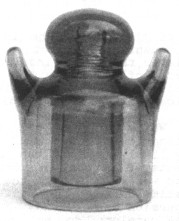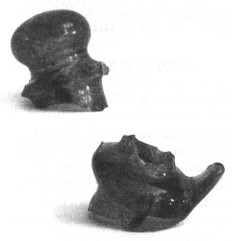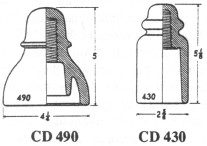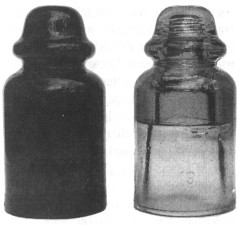Foreign Insulators
by Marilyn Albers
Reprinted from "Crown Jewels of the Wire", April 1989, page 26
BROOKFIELD AND THE FRENCH CONNECTION
In the December, 1988, issue of CROWN JEWELS, Editor Carol McDougald, who had
attended the Sussex, New Jersey show in September, reported seeing there a
broken piece of a CD 640 Gingerbread Man that David Wiecek (Spotsville, NJ) had
dug at Brookfield's New Jersey dump. She speculated that "Marilyn Albers,
Foreign Insulator Editor, would have a field day deciding how Brookfield and
France were associated!" She was right -- I rolled up my eyes and dusted off
my thinking cap!
I sent a quick note to David and he agreed to loan me the glass
shard, which he said he's actually found on the bank of the Raritan River at
Brookfield's old factory site in Old Bridge. He added that Bob McElvaney (Bricktown,.
NJ) had also come across a chunk of the 640 style and in the same general
location, but closer to where construction of some apartments was taking place.
David and Bob did not go scouting together, but soon found out about each
other's discovery, and with a good word put in by David, the mailman also
brought me the piece Bob had found. These are shown together as well as a
complete CD 640, for those of you who are new at collecting or who still are not
familiar with the numbers we have been using for foreign glass insulators since
1981. I believe you will recognize it!

CD 640 "Gingerbread Man"
The specimen at the left (on the following page) belongs to David and is
definitely the crown portion of a Gingerbread Man. Bob's is on the right and
includes one arm and parts of the outer skirt and the petticoat. Both pieces are
identical in color -- that greenish aqua that is so typical of Brookfield. N.R.
"Woody" Woodward says these are of Brookfield production! He can tell
just by looking at them, even though he has no other facts to go on. Neither of
the two shards has even a partial embossing, and whatever might have been on
the skirt is lost forever. That's sad, indeed. My kingdom for a piece of that
skirt with even a letter or two still intact!

Broken "Gingerbread Men " shards
found in New Jersey.
The interesting thing is that, in both cases, enough of the glass remains to
show the 3/4" pinhole, so typical of French insulators this size, but the threads are the standard U.S. 4 per inch! Not the 5 or 6 or more per inch that
we usually see in a CD 640. I have 28 of them in my own collection, and all have
the smaller thread. None are quite this color.
This is definitely not a style
that Brookfield would have made for use in America. It had to be made for
export, but where and for whom? Had an order been placed? How long ago? Or was
Brookfield merely experimenting? If so, any broken pieces found in the dump
would seem to indicate the insulators were unsatisfactory. But that is unlikely, because the CD 640 was as versatile to the French as the Hemingray-42
has been to us.
The plot thickens! Along comes another puzzler. In my January,
1989 column, you read that Bill Snell and Andy Gibson were positive they had
seen CD 145 aqua beehives on a line as they drove into Paris last summer. That
color rang a bell immediately and they both said "Brookfield
beehives!" They were unsuccessful in bringing back any specimens, however, and they never got close enough to see any markings, but
the nagging questions remains, "Could Brookfield have sent insulators to
France?" I have no answers, but if anyone out there in "readerdom"
can shed any light on this, please let me know! We could open so many more doors......
WORDS OF CAUTION FROM LAURA
When Laura Monckton (Sydney, Australia) attended the 1988 Houston National
last July, she was impressed by the fact that the NIA is earnestly trying to
educate collectors and to warn them about fake, altered and repaired insulators.
She took home a copy of Mike Guthrie's new book on this subject, which is
excellent. For your own protection, you need to have a copy. (See Mike's ad
under "PUBLICATIONS" in this issue.) Laura had heard that a certain
individual in her area was creating new colors in Australian glass insulators by subjecting them to ultra-violet
radiation and, in some cases, selling them to antique dealers as authentic
pieces! Particularly the large purple AGEE bells, CD 490. This person pays a
technician to do the job for him, he does not do it himself. Laura took it upon
herself to have (and paid to have) some purple C.C.G. CD 430's treated in this
manner, ONLY so we could see the resulting color and could be in the lookout. She
is not pushing them as authentic, by any means. We do, in fact, owe her many
thanks!

Too bad the photo below does not show you the color, but it can be described as a very dark, almost black glass
cobalt/purple (on the left). Actually,
it is really beautiful, and it makes one wish it were for real. (Piece on the
right is authentic sca color.) But don't be fooled, says Laura. So be on the lookout for any of these treated and
extremely dark purple insulators -- so much more purple than royal that they look
blue! If you see any you feel are suspicious, please let Mike Guthrie or any of
the other NIA Board members know about it. I can't believe people are even
tampering with foreign insulators.

If you are at any of the following shows this year, come to my table and see
the sample I have from Laura. See you at Port Arthur, Texas (March 18-19),
Cedar Rapids (IA), Enumclaw (WA), San Luis Obispo (CA), Pearland (TX),
Allentown (PA), Bakersfield (CA) and London (OH).
A line was dropped in the November, 1988, letter from Laura Monckton which
appeared in this column. It read: "I have never seen so many (ahem) dealers
whom I only knew by name....." and it should have read: "I have never seen so many
(ahem) "Foreign" insulators together! It was great to meet with
collectors and dealers whom I only knew by name...." In no way did Laura mean for the
letter to sound as though she was poking fun at the dealers, but, rather at
referring to all the American insulators as "foreign" insulators. Your
editor apologies for the missing words which altered the intent of Laura's
letter.
|
